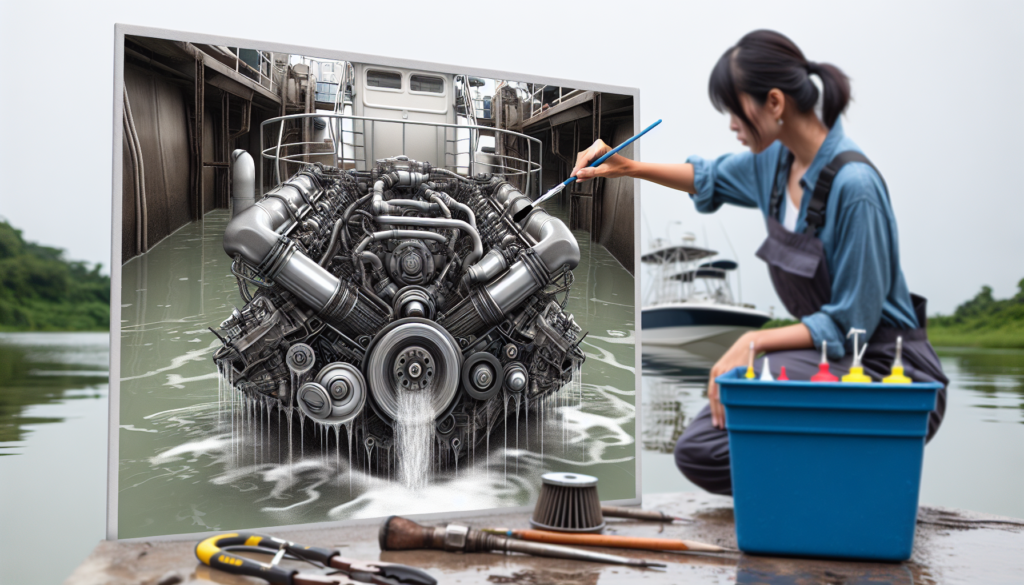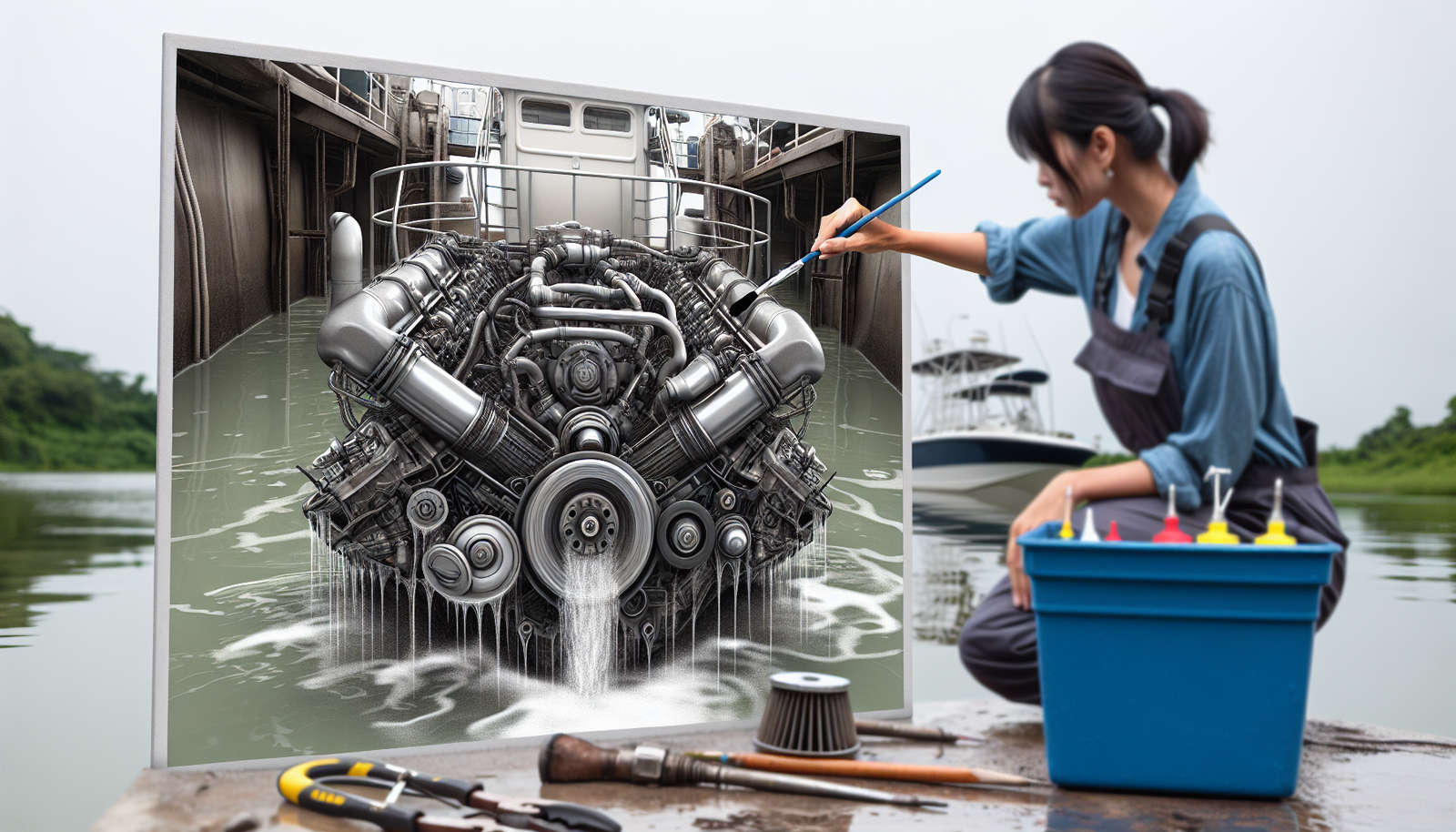Sailing through calm waters with the wind playing through your hair is an experience like no other. However, the longevity of these joyous moments is highly dependent on how well you take care of your boat’s engine. Much like the human body, your boat’s engine needs to remain cool to function efficiently, and this is where the cooling system comes into play. With the article ‘How to Maintain and Clean Your Boat Engine’s Cooling System,’ you’ll embark on a journey towards prolonging the life and enhancing the performance of your boat. Watch your worries drift away as you learn the ins and outs of keeping your cooling system in prime condition, ensuring that your leisurely escapades remain uninterrupted.

Understanding the Importance of a Clean Engine Cooling System
Maintaining a high-performance engine is no easy task, especially for the marine enthusiast. One of the key systems in your boat that ensures smooth and healthy operation of your engine is the cooling system. It plays a crucial role in maintaining optimal running temperatures, hence protecting your engine from overheating, and irreversible possible damages. The engine cooling system is as essential as the engine oil. It keeps the engine clean and cool, extending its life and ensuring a smooth journey.
Roles of the engine cooling system
The major role of the engine’s cooling system is to remove excess heat from the engine. The cooling system transfers heat from your engine to the air or water around, depending on the type of cooling system. This process ensures a steady engine temperature for efficient operation. Aside from controlling the temperature, the cooling system also helps to heat the engine quickly during cold start-ups, which is crucial to reduce wear, emissions, and to improve the engine’s efficiency.
What happens when the cooling system is faulty
When your cooling system is not functioning properly, it can produce a variety of issues. If heat isn’t effectively removed from the engine, it may lead to overheating, which can cause substantial engine damage including warped heads, blown head gaskets, and even engine failure. Additionally, a leak in the cooling system could mix anti-freeze into the engine oil, which might wreck the engine’s internals. As such, maintaining your cooling system is paramount to ensuring the longevity and integrity of your boat engine.
Identifying the Different Types of Boat Cooling Systems
Boat cooling systems fall broadly into three categories namely: closed cooling system, raw water cooling system, and half system cooling system. They each function differently and thus present unique maintenance requirements.
Closed cooling systems
A closed cooling system operates similarly to a car’s cooling system. It features an enclosed circuit with the coolant being cooled by raw water that passes through a heat exchanger. This type of system is effective, but may require regular flushing and topping up of coolant.
Raw water cooling systems
In a raw water cooling system, the engine is cooled directly by water from the surrounding environment. This system is relatively simple and efficient, but the cooling system requires frequent checks due to possible accumulation of salts and sediments that might cause damage to the system.
Half system cooling systems
A half system cooling system integrates aspects of both the raw water and closed cooling systems. It employs raw water to cool the exhaust manifolds while utilizing anti-freeze to protect the more sensitive engine parts from corrosion and deposits. This presents a balance but can be harder to maintain effectively due to its hybrid design.
Evaluating the Condition of Your Boat’s Cooling System
Part of keeping your boat engine running smoothly involves assessing the condition of your cooling system regularly. This proactive approach can save time, money, and potential damage.
Routine inspection of the cooling system
Routinely inspecting your cooling system can help identify and rectify issues before they exacerbate. Look for leaks, damaged hoses, or blocked passages. The coolant level and condition should also be checked regularly. A change in the coolant color or the presence of debris might indicate an issue that needs immediate attention.
Identifying tell-tale signs of a compromised cooling system
If the engine frequently overheats, runs inefficiently or there’s a significant loss of coolant, this could be a clear sign of cooling system failure. Rust or discoloration in the coolant or unusual noise from the pump could also be indicative of a compromised cooling system.
Scheduling professional inspections
While routine at-home inspections are necessary, having a professional inspect your cooling system at least once a year is advisable. Professionals can spot potential problems that you may miss and can offer solutions to prevent future complications.

Materials and Tools Needed for Cleaning and Maintenance
A few tools and materials come in handy when cleaning and maintaining your boat cooling system.
List of basic cleaning materials
Some basic cleaning materials you would need are fresh water, coolant, a coolant tester, clean rags, a wire brush, and so forth. You might also require specific cleaning agents to tackle rust or mineral deposits.
Special tools for specific tasks
Special tools such as a radiator pressure tester, thermostat tester, and hose removal tools might be necessary for more specific tasks, like testing pressure in the cooling system or changing the hoses.
Safety equipment for maintenance work
Lastly, remember to use safety equipment such as gloves, safety glasses, and appropriate clothing to protect yourself during the cleaning and maintenance work.
Preventive Maintenance for the Cooling System
Routine preventive maintenance can help keep your cooling system in top shape and elongate its lifespan.
Regular flushing of the cooling system
Regularly flushing your system is essential to remove deposits and contaminants that could cause blockage or corrosion. For raw water cooling systems, flushing with fresh water helps remove salt and other harmful deposits.
Listening for abnormal engine noises
Keep an ear out for any strange noises as these could be early signs of a faulty pump or other issues within the cooling system.
Keeping the engine clean and free of debris
Keeping your engine compartment clean is key to preventing the intake of debris, as these could block the system or cause premature wear.
Thorough Cleaning of the Cooling System
A thorough cleaning of the cooling system is a crucial part of maintenance, and should be done with care to ensure no damage to the system.
Step-by-step guide for cleaning the cooling system
Start by draining the old coolant. Following this, add a flush cleaning solution and fill with water. Run the engine for the specified time on the flush solution label. Afterwards, drain the system again and fill with fresh coolant.
Using cleaning agents and how to choose the right one
Cleaning agents can be integral in eliminating rust and mineral deposits from your cooling system. Always select a cleaner that’s safe for your engine and follow the manufacturer’s instructions for use.
Ensuring the cleaning is thorough without damaging the system
It’s crucial to ensure a thorough clean without causing damage. Always use non-abrasive methods and avoid forcing components apart.
Replacing Parts of the Cooling System
Sometimes, certain parts of the cooling system may need to be replaced due to wear or damage.
Identification of parts that need to be replaced
Parts susceptible to wear such as hoses, belts, and the water pump should be checked regularly. Look for signs of fraying, cracking, leaks, or inefficiency.
How to properly remove and replace components
Make sure to follow the manufacturer’s instructions while removing or replacing components. Keep track of where each part goes, and remember to properly seal anything that’s been disassembled.
Where to source quality replacements parts
Procure replacement parts from a reliable source, preferably, the original manufacturer. Aftermarket parts should meet OEM specifications.
Testing and Verifying the Functionality of the Cooling System
After cleaning or maintenance, it’s essential to test the system to ensure it’s operating properly.
How to test the boat after maintenance
Start by running the engine while moored to ensure the cooling system operates smoothly under normal conditions. Observe the coolant level and temperature gauge.
Essential system checks post-maintenance
Check all hoses, belts, and connections for leaks. Verify the flow of coolant and make sure there is no overheating after running the engine for some time.
Identify potential issues after the maintenance process
Pay attention to any abnormalities such as strange noises, excessive heat, or drastic changes in coolant levels.
Periodic Maintenance Schedule for Boat Cooling System
Setting up a regular maintenance schedule can greatly improve the longevity of your cooling system and by extension, your engine.
Proposed maintenance frequency for different types of boats
Depending on the type and usage of the boat, a suitable maintenance frequency can be determined. As a general rule, an annual comprehensive inspection and cleaning is advisable. However, for boats that stay in the water year-round or are frequently used, more frequent maintenance may be necessary.
Understanding the influence of boat usage on maintenance frequency
Boats that are used intensively or in harsh conditions may require more frequent maintenance. This could mean bi-annual or even quarterly checks and cleanings.
Pre and post-season checks for the cooling system
It’s recommended to check the cooling system before the start and after the end of every boating season to prevent wear, or fix any damage caused during the season.
Facing Challenges and Troubleshooting Issues with the Cooling System
There can be various challenges when it comes to troubleshooting the cooling system issues. Understanding what you can handle and when to seek professional help is essential.
Addressing common cooling system issues
For common issues like leaks, loose belts, or a clogged radiator, you could perform a DIY fix provided you have the knowledge. Refer to the manufacturer’s manual for troubleshooting guides and tips.
Understanding when to seek the help of a professional
When you can’t confidently diagnose or repair the issue, it’s best to consult a professional. This includes cases of frequent overheating, unusually noisy pumps, or visible damage to any cooling system component.
DIY fixes vs professional repair: knowing when to choose
Always opt for professional repair when the job is beyond your skill level. While small issues could be tackled with DIY fixes, serious problems or replacements may require professional intervention to ensure it’s done correctly and safely, avoiding further damage.
In conclusion, while maintaining the engine’s cooling system might seem like a task best left to the professionals, with preparedness and a bit of knowledge, it’s something you, a boat owner, can certainly tackle. So, make it a habit to inspect, clean, and maintain your boat engine’s cooling system regularly for a smoother and safer journey on the water.

